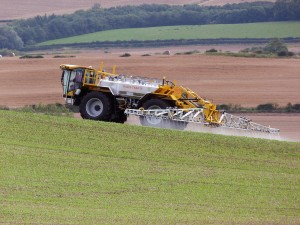08
Nov
CDC Report Finds Occupational Pesticide Poisoning Widespread, with Farmworkers at Greatest Risk
(Beyond Pesticides, November 8, 2016) A report published last month from the U.S. Centers for Disease Control and Prevention (CDC) finds that over 2,600 cases of acute pesticide poisoning occurred among workers in 12 states between 2007 and 2011. The report, published by CDC’s National Institute for Occupational Safety and Health (NIOSH), highlights the hazards conventional pesticides pose to both farm and non-farm workers who apply these inherently toxic chemicals. Results of this study underscore the importance of calls from public health and farmworker advocacy groups for improving the protection of workers who grow and harvest the food that makes its way to American’s dinner plates. The results also support a wholesale transition away from toxic chemicals in favor of organic and sustainable alternatives.
CDC’s report, collected from 12 farming states (including California, Florida, Iowa, Louisiana, Michigan, Nebraska, North Carolina, New Mexico, New York, Oregon, Texas, and Washington), focuses on acute pesticide poisonings. The data gathered comes from NIOSH’s Sentinel Event Notification System for Occupational Risks (SENSOR) program, a project that has tracked pesticide-related illness in the U.S. since 1987.
The report finds that pesticide poisoning incidents among agricultural workers are 37 times those of nonagricultural workers. Proportionally, acute poisoning rates among nonagricultural pesticide applicators were 0.5/100,000, while rates for farmworkers were 18.6/100,000. Most poisonings result from exposure to insecticides or herbicides. Within insecticide exposures, synthetic pyrethroids account for the highest number of incidents, while with herbicides glyphosate account for most poisoning events.
CDC classifies incidents as either low, moderate, or high severity. Low severity incidents usually do not require treatments and individuals return to work within three days. Moderate severity incidents require treatment, but are usually not life-threatening, and individuals return to work within 5 days. High severity cases are life threatening, require hospitalization, often lose more than 5 days from work, and may result in permanent damage. The report found 80% of recorded cases were low severity, 18% moderate severity, and one percent high severity.
However, it is critical to understand that these numbers only tell part of the story. As the study notes, the 2,600 acute poisoning cases it was able to document are likely an underestimate. This is because many pesticide-related illnesses are not captured by regulators as they are never reported, or individuals do not seek medical care. There are additional issues with health care providers being able to diagnose pesticide poisonings. The report notes, “[B]ecause the signs and symptoms of acute pesticide-related illnesses are not pathognomonic, and because most health care professionals are not acquainted with the recognition and management of these illnesses, many persons who seek medical care might not receive an accurate diagnosis.” Even when there is an accurate diagnosis, the study explains that many cases are simply not reported, despite the fact that each participating state has a mandatory requirement to report pesticide-related illnesses.
Many farmworkers do not report their illnesses to their employers because of the risk that they will lose their job. Although CDC may classify an illness as “low severity,” the fact is that with many farmworkers any amount of time off work means they will be fired. After over 20 years, the U.S. Environmental Protection Agency recently updated its Agricultural Worker Protection Standards, which make important progress in protection, but did lack some significant safety measures. Ultimately, the key to making changes in the lives of farmworkers and farmworker families will be adequate enforcement of new provisions, and a transition to safer practices.
Geoffrey Calvert, MD, lead author of the CDC report, has a long history of tracking pesticide poisoning’s and authoring analyses of incidents in peer-reviewed literature. In 2015, Dr. Calvert evaluated a farmworker poisoning incident in Washington State, where over 20 farmworkers were sickened, finding multiple shortfalls in terms of following and enforcing pesticide law. He spoke about the SENSOR program at Beyond Pesticides 33rd National Pesticide Forum in Orlando, Florida last year. Click here to watch his speech.
Our food choices have a direct effect on those who grow and harvest what we eat around the world. This is why food labeled organic is the right choice. In addition to serious health questions linked to actual residues of toxic pesticides on the food we eat, our food buying decisions support or reject hazardous agricultural practices, and the protection of farmworkers and farm families. To learn about how buying organic food can help protect farmworkers, see Beyond Pesticides’ Eating with a Conscience guide. And for more information on how you can get educated and active in protecting farmworkers and changing our agricultural system towards safer practices, see Beyond Pesticides new Agricultural Justice webpage.
Source: Occupational Health and Safety, Centers for Disease Control and Prevention











I totally agree with the sentiment that most health workers are short in correctly diagnosing acutely poisoned clients. A study in a regional hospital in Kenya found that over 50% of diagnosis was inaccurate. http://www.poisonsense.com helps health workers in correctly identifying and managing acute poisons
November 16th, 2016 at 5:51 am